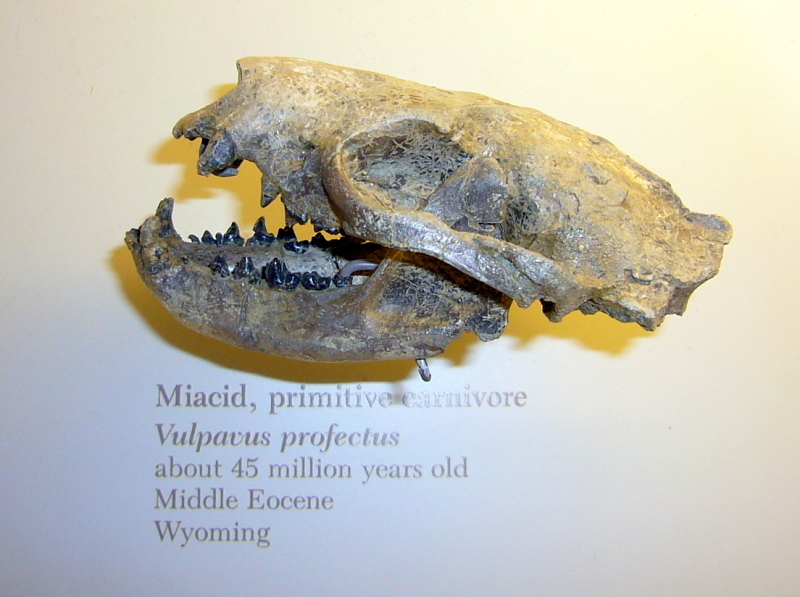|
Oodectes
''Oodectes'' is an extinct genus of Miacidae Miacids are extinct primitive carnivoramorphans within the family Miacidae that lived during the Paleocene and Eocene epochs, about 62–34 million years ago. Miacids existed for approximately . Miacids are thought to have evolved into the .... Notes Sourcesfindarticles.com*''Fossil Mammalia of the Huerfano Formation, Eocene, of Colorado'' by Peter Robinsonnmnaturalhistory.org † Miacids Eocene carnivorans [...More Info...] [...Related Items...] OR: [Wikipedia] [Google] [Baidu] |
Carnivoraformes
Carnivoraformes ("carnivoran-like forms") is a clade of Placentalia, placental mammals that includes the modern order Carnivora and its extinct stem-relatives. Classification and phylogeny Classification In 2010 Flynn, Finarelli & Spaulding named a new clade Carnivoraformes within Carnivoramorpha, containing carnivorans and "Miacidae, miacids" but not Viverravidae, viverravids. The authors defined Carnivoraformes as the clade containing Carnivora and all taxa that are more closely related to Carnivora (represented by ''Wolf, Canis lupus'') than to viverravids (represented by ''Viverravus, Viverravus gracilis''). * ''Clade'': Carnivoraformes ** Order: Carnivora (carnivorans) *** Suborder: Caniformia ("dog-like" carnivorans) *** Suborder: Feliformia ("cat-like" carnivorans) ** Family: †Quercygale, Quercygalidae ** (unranked): †''Gracilocyon''/''Oodectes'' clade *** Genus: †''Eogale'' *** Genus: †''Gracilocyon''(Paraphyly, paraphyletic genus) *** Genus: †''Oodectes'' ... [...More Info...] [...Related Items...] OR: [Wikipedia] [Google] [Baidu] |
Miacidae
Miacids are extinct primitive carnivoramorphans within the family Miacidae that lived during the Paleocene and Eocene epochs, about 62–34 million years ago. Miacids existed for approximately . Miacids are thought to have evolved into the modern carnivorous mammals of the order Carnivora. They were small carnivores, superficially marten-like or civet-like with long, lithe bodies and long tails. Some species were arboreal, while others lived on the ground. They probably fed on invertebrates, lizards, birds, and smaller mammals like shrews and opossums. Their teeth and skulls show that the miacids were less developed than modern carnivorans. They had carnivoran-type carnassials, but lacked fully ossified auditory bullae (rounded protrusions). Classification Miacidae as traditionally conceived is not a monophyletic group; it is a paraphyletic array of stem taxa. Traditionally, Miacidae and Viverravidae had been classified in a superfamily, Miacoidea. Today, Carnivora a ... [...More Info...] [...Related Items...] OR: [Wikipedia] [Google] [Baidu] |
Miacids
Miacids are extinct primitive carnivoramorphans within the family Miacidae that lived during the Paleocene and Eocene epochs, about 62–34 million years ago. Miacids existed for approximately . Miacids are thought to have evolved into the modern carnivorous mammals of the order Carnivora. They were small carnivores, superficially marten-like or civet-like with long, lithe bodies and long tails. Some species were arboreal, while others lived on the ground. They probably fed on invertebrates, lizards, birds, and smaller mammals like shrews and opossums. Their teeth and skulls show that the miacids were less developed than modern carnivorans. They had carnivoran-type carnassials, but lacked fully ossified auditory bullae (rounded protrusions). Classification Miacidae as traditionally conceived is not a monophyletic group; it is a paraphyletic array of stem taxa. Traditionally, Miacidae and Viverravidae had been classified in a superfamily, Miacoidea. Today, Carnivora ... [...More Info...] [...Related Items...] OR: [Wikipedia] [Google] [Baidu] |
Journal Of Paleontology
The ''Journal of Paleontology'' is a peer-reviewed scientific journal covering the field of paleontology. It is published by the Paleontological Society. Indexing The ''Journal of Paleontology'' is indexed in: *BIOSIS Previews *Science Citation Index *The Zoological Record *GeoRef __NOTOC__ The GeoRef database is a bibliographic database that indexes scientific literature in the geosciences, including geology. Coverage ranges from 1666 to the present for North American literature, and 1933 to the present for the rest of th ... References Paleontology journals Publications established in 1927 Academic journals published by learned and professional societies Cambridge University Press academic journals Bimonthly journals Paleontological Society {{paleo-journal-stub ... [...More Info...] [...Related Items...] OR: [Wikipedia] [Google] [Baidu] |
Eocene Carnivorans
The Eocene ( ) Epoch is a geological epoch that lasted from about 56 to 33.9 million years ago (mya). It is the second epoch of the Paleogene Period in the modern Cenozoic Era. The name ''Eocene'' comes from the Ancient Greek (''ēṓs'', "dawn") and (''kainós'', "new") and refers to the "dawn" of modern ('new') fauna that appeared during the epoch. The Eocene spans the time from the end of the Paleocene Epoch to the beginning of the Oligocene Epoch. The start of the Eocene is marked by a brief period in which the concentration of the carbon isotope 13C in the atmosphere was exceptionally low in comparison with the more common isotope 12C. The end is set at a major extinction event called the ''Grande Coupure'' (the "Great Break" in continuity) or the Eocene–Oligocene extinction event, which may be related to the impact of one or more large bolides in Siberia and in what is now Chesapeake Bay. As with other geologic periods, the strata that define the start and end of ... [...More Info...] [...Related Items...] OR: [Wikipedia] [Google] [Baidu] |
Eocene Mammals Of North America
The Eocene ( ) Epoch is a geological epoch that lasted from about 56 to 33.9 million years ago (mya). It is the second epoch of the Paleogene Period in the modern Cenozoic Era. The name ''Eocene'' comes from the Ancient Greek (''ēṓs'', "dawn") and (''kainós'', "new") and refers to the "dawn" of modern ('new') fauna that appeared during the epoch. The Eocene spans the time from the end of the Paleocene Epoch to the beginning of the Oligocene Epoch. The start of the Eocene is marked by a brief period in which the concentration of the carbon isotope 13C in the atmosphere was exceptionally low in comparison with the more common isotope 12C. The end is set at a major extinction event called the ''Grande Coupure'' (the "Great Break" in continuity) or the Eocene–Oligocene extinction event, which may be related to the impact of one or more large bolides in Siberia and in what is now Chesapeake Bay. As with other geologic periods, the strata that define the start and end of t ... [...More Info...] [...Related Items...] OR: [Wikipedia] [Google] [Baidu] |
.jpg)


